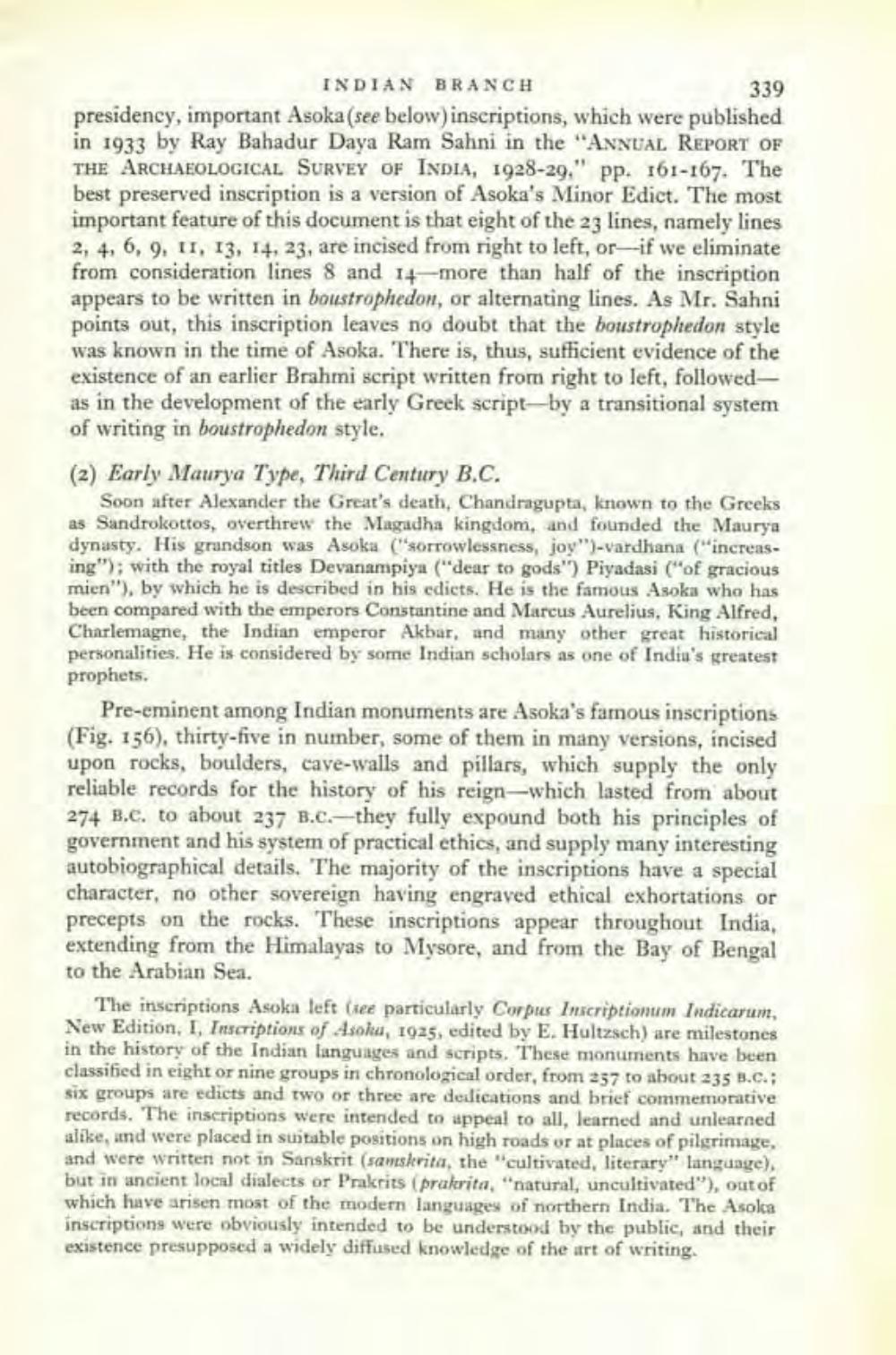________________
INDIAN BRANCH
339 presidency, important Asoka (see below) inscriptions, which were published in 1933 by Ray Bahadur Daya Ram Sahni in the "ANNIAL REPORT OF THE ARCHAEOLOGICAL SURVEY OF INDIA, 1928-29. pp. 161-167. The best preserved inscription is a version of Asoka's Minor Edict. The most important feature of this document is that eight of the 23 lines, namely lines 2, 4, 6, 9, 11, 13, 14, 23, are incised from right to left, or-if we eliminate from consideration lines 8 and 14-more than half of the inscription appears to be written in boustrophedon, or alternating lines. As Mr. Sahni points out, this inscription leaves no doubt that the boustrophedon style was known in the time of Asoka. There is, thus, sufficient evidence of the existence of an earlier Brahmi script written from right to left, followedas in the development of the early Greek script-by a transitional system of writing in boustrophedon style. (2) Early Maurya Type, Third Century B.C.
Soon after Alexander the Great's death, Chandragupta, known to the Greeks as Sandrokottos, overthrew the Magadha kingdom, and founded the Maurya dynasty. His grandson was Asoka ("sorrowlessness, joy")-vardhana ("increasing"); with the royal titles Devanampiya ("dear to gods"') Piyadasi ("of gracious mien"), by which he is described in his edicts. He is the famous Asoka who has been compared with the emperors Constantine and Marcus Aurelius, King Alfred, Charlemagne, the Indian emperor Akbar, and many other great historical personalities. He is considered by some Indian scholars as one of India's greatest prophets.
Pre-eminent among Indian monuments are Asoka's famous inscriptions (Fig. 156), thirty-five in number, some of them in many versions, incised upon rocks, boulders, cave-walls and pillars, which supply the only reliable records for the history of his reign-which lasted from about 274 B.e. to about 237 B.C.--they fully expound both his principles of government and his system of practical ethics, and supply many interesting autobiographical details. The majority of the inscriptions have a special character, no other sovereign having engraved ethical exhortations or precepts on the rocks. These inscriptions appear throughout India, extending from the Himalayas to Mysore, and from the Bay of Bengal to the Arabian Sea.
The inscriptions Asoka left tree particularly Corpus Inscriptionum Indicarum, New Edition, I, Inscriptions of Asoka, 1925, edited by E. Hultzsch) are milestones in the history of the Indian languages and scripts. These monuments have been classified in eight or nine groups in chronological order, from 257 to about 235 B.C.; six groups are edicts and two or three are dedications and brief commemorative records. The inscriptions were intended to appeal to all, learned and unlearned alike, and were placed in suitable positions on high roads or at places of pilgrimage, and were written not in Sanskrit (samskrita, the "cultivated, literary language), but in ancient local dialects or Prakrits (prakrita, "natural, uncultivated"), out of which have arisen most of the modern languages of northern India. The Asolca Inscriptions were obviously intended to be understood by the public, and their existence presupposed a widely diffused knowledge of the art of writing.




